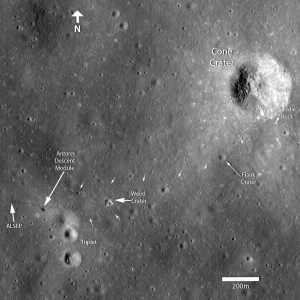Scientists vs. The Icy Commander

In 1961, Alan B. Shepard’s successful 15-minute sub-orbital hop gave President Kennedy the high cover needed to announce a reach for the Moon, “by the end of this decade.” America’s spirit was lifted and Alan Shepard became a national hero, getting ticker tape parades and White House receptions. Then, as in a Greek tragedy, he was struck from the flight list after developing Meniere’s syndrome (an imbalance of the inner ear). His flying days were over. Or were they?
Shepard, a smart, tough, no-nonsense aviator, took a job helping Deke Slayton (previously grounded by a heart murmur) run the Astronaut Office. Shepard and Slayton picked all flight crews for the Gemini and Apollo missions. Very early on, it became clear that you did not cross Al Shepard, lest your career come to a screeching halt. Shepard never stopped his Apollo training or flying in the T-38, even though he had to “backseat it” with another astronaut. His personality was memorably captured in Tom Wolfe’s book, The Right Stuff, as “The Icy Commander.”
After taking a chance on experimental surgery to correct his inner ear problem in 1969, he successfully returned to active flight status and looked ahead to an Apollo flight assignment. Rejected for the Commander’s seat on the next available flight by NASA Headquarters (on the grounds that he needed more training time), he was named to command a subsequent flight, while Jim Lovell was named Commander of Apollo 13.
Geologists who worked on the Apollo training were ecstatic – Lovell was one of their favorite pilot astronauts, a smart, capable guy with a keen eye and an analytic mind. He was being sent to Fra Mauro, the first highland site to be visited on the Moon. This region was considered a key locale to decipher lunar geological history, being located on the ejecta blanket of the Imbrium basin, the largest impact crater on the near side.
Jim Lovell was considered the right man to study this site and collect the key samples scientists needed to help unlock the secrets of the Moon. Unfortunately, with the failure of Apollo 13, Jim Lovell didn’t land on the Moon. Still, the Fra Mauro site was considered so important, it became the designated landing site for Apollo 14, eighteen months later.
Uh-oh. Lunar scientists didn’t have Jim Lovell to explore with—they had drawn the “Icy Commander,” the guy who cheerfully admitted that, compared to aeronautics, he thought geology was a low-grade science. Nevertheless, Shepard assured the Apollo scientists he would try to do the best job he could for them.
While successful in almost every way, the Apollo 14 mission was not without controversy. Cone crater, a large young impact feature, had apparently dug up rocks from deep within the Fra Mauro Formation, including it was hoped, ejecta from the Imbrium basin. During their second moonwalk, Al Shepard and Ed Mitchell trudged up steep slopes leading to Cone, dragging along their Modularized Equipment Transporter (MET), a small pull-cart designed to carry tools and samples with them, getting more winded and disoriented with each step. Getting to the rim of Cone crater was considered critical to the scientific success of the mission.
At 47, Shepard was the oldest man to fly to the Moon and many felt that he was out of shape and not up to the rigors of lunar trekking (which didn’t explain why Ed Mitchell was also having problems.) Moreover, it seemed that Shepard was all too eager to abandon the trek and declare victory after he radioed to the ground that he thought they were already at the rim of Cone crater. (Enough with the hiking trip! We’re running out of time and consumables. Let’s sample this area and call it the rim of Cone crater.)
Scientists in the back room were aghast. Getting Cone crater samples was critical to mission success. And now this old, panting geezer was destroying their chance to unlock a deep secret about the Moon. Although they put on a good face, scientists were resentful; after all their work on geological training, the “Icy Commander” simply declares victory and turns for home. Adding insult to their perceived injury, back at the Lunar Module, Shepard pulled out a 6-iron and conducted a little sand trap practice. (He abandoned the quest for Cone crater – to play golf, no less!)
Now, thirty-eight years later, we’ve just received a magnificent picture of the Apollo 14 landing site from the Lunar Reconnaissance Orbiter Camera (LROC). Its quality is so good we can see the path of the astronauts footprints and MET tracks on the Moon. It is even possible to follow their tracks all the way up to Cone crater—to the point where Al Shepard declared victory.
Oops. Al Shepard was right. He was at the rim of Cone crater. Terrain around the rim is so hilly that he and Ed Mitchell didn’t know they had reached the rim; the deep crater interior is just over a slight rise, a few tens of meters north of where they were. The samples that Shepard and Mitchell collected do represent the deepest ejecta from Cone crater, thereby fulfilling that goal geologists set many moons ago. For almost 40 years, the “Icy Commander” was right. Yet his name lived in infamy in lunar geologic circles.
If there is a moral to this story, it could be that scientists should never state something is absolutely known and settled. It's likely they'll be proven wrong.
/https://tf-cmsv2-smithsonianmag-media.s3.amazonaws.com/accounts/headshot/blog_headshot_spudis-300x300.jpg)
/https://tf-cmsv2-smithsonianmag-media.s3.amazonaws.com/accounts/headshot/blog_headshot_spudis-300x300.jpg)